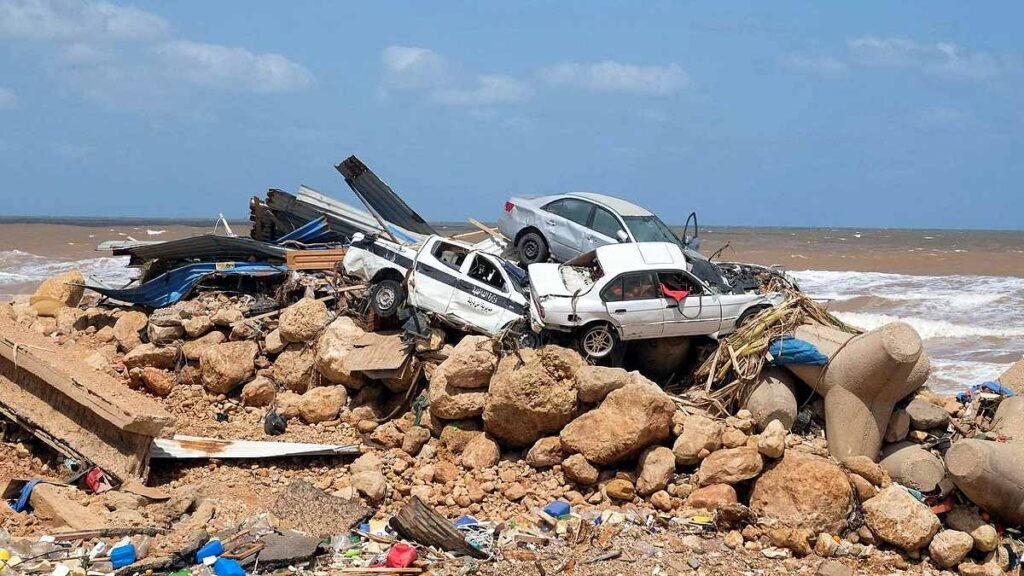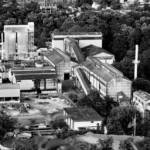In the arid and unforgiving landscapes of Libya, a natural disaster of unprecedented proportions struck the city of Derna, leaving a trail of devastation in its wake. This tragic event, which unfolded as a result of torrential rainfall and massive flooding, not only altered the terrain of this North African city but also claimed the lives of thousands and left countless others unaccounted for.
The Unpredictable Fury of Nature In Libya
Libya, a nation primarily known for its vast stretches of desert and scorching temperatures, is not typically associated with heavy rainfall or flooding. However, nature has a way of reminding us of its unpredictability. In late October 2022, Derna, a city located on the country’s eastern coast, experienced an unprecedented deluge that caught both residents and authorities off guard.
The Catastrophic Impact

ALSO READ: Significant Climate Impacts: Scientists Find Urea In The Atmosphere
The torrential rain in Derna led to flash floods that swept through the city with astonishing force. The sheer volume of water inundated homes, streets, and infrastructure, turning the city into a disaster zone. As the water levels surged, buildings collapsed, and vehicles were swept away like toys.
The Human Toll
Tragically, the floods claimed the lives of approximately 5300 people, leaving behind a grief-stricken community. Families were torn apart, and the city’s healthcare system struggled to cope with the surge in injuries and casualties. Hospitals were inundated with patients, and medical supplies quickly ran short.
The Missing Thousands
In addition to the lives lost, an estimated 10,000 people remain missing in the aftermath of the disaster. The chaos and destruction caused by the floods have made it difficult to account for all residents, adding to the heartache and uncertainty gripping Derna.
Rescue and Relief Efforts

In the face of this catastrophe, the Libyan government, alongside international organizations and neighboring countries, launched a massive rescue and relief operation. Helicopters and boats were deployed to reach the stranded and provide much-needed aid. Temporary shelters were set up to house those who had lost their homes, and medical teams worked tirelessly to tend to the injured.
The Rebuilding Process
The road to recovery for Derna will be long and challenging. Reconstructing the city’s infrastructure, providing psychological support to survivors, and locating the missing are just a few of the immense challenges ahead. It will require concerted efforts from both the Libyan government and the international community to help Derna regain its footing.
Lessons Learned
The tragic events in Derna serve as a stark reminder of nature’s unpredictability and the importance of disaster preparedness, even in regions not traditionally prone to such events. As climate patterns continue to evolve, it becomes increasingly vital for communities worldwide to adapt and strengthen their resilience against extreme weather conditions.
Climate Change and Extreme Weather Events

The catastrophic floods in Derna are a stark reminder of the growing impact of climate change on our planet. While Libya is known for its arid climate and desert landscapes, climate change is causing shifts in weather patterns that can lead to extreme events like the one witnessed in Derna. Rising global temperatures have the potential to increase the intensity and frequency of such events, posing a significant threat to vulnerable regions.
The Role of Preparedness
In the face of these changing climate dynamics, disaster preparedness and mitigation efforts become critical. Governments and communities in regions prone to sudden environmental shifts must invest in infrastructure and policies designed to withstand and respond effectively to extreme weather conditions. This includes the development of early warning systems, the construction of resilient buildings, and the establishment of well-coordinated disaster response mechanisms.
International Solidarity

The Libya floods did not go unnoticed by the international community. Neighboring countries, humanitarian organizations, and nations across the globe offered their assistance and support to the beleaguered city of Derna. This outpouring of solidarity highlights the importance of global cooperation in times of crisis. It serves as a powerful testament to our shared humanity and the willingness of nations to come to each other’s aid when faced with adversity.
Long-Term Sustainability
As Derna begins the long process of recovery and rebuilding, it’s essential to consider the sustainability of these efforts. Infrastructure and urban planning should be geared towards long-term resilience, incorporating eco-friendly practices that mitigate the impact of future environmental challenges. Sustainability not only ensures a safer and more secure future but also contributes to a healthier planet.
Raising Awareness
The Libya floods in Derna, though tragic, provide an opportunity to raise awareness about the broader implications of climate change and the need for proactive measures to address it. Public discourse and media coverage of such events can catalyze discussions on climate policy, encourage individuals to adopt more sustainable lifestyles, and motivate governments to take bold action on reducing greenhouse gas emissions.
Empowering Local Communities
While international aid plays a vital role in disaster response, empowering local communities is equally important. Building resilience at the grassroots level involves education, training, and community engagement. When individuals and communities are equipped with the knowledge and resources to prepare for and respond to disasters, the overall impact can be mitigated.
Conclusion
The Libya floods in Derna stand as a sobering reminder of the far-reaching consequences of climate change and the importance of preparedness and international cooperation in times of crisis. As we extend our support to the people of Derna, we must also commit ourselves to addressing the root causes of such disasters by taking meaningful steps towards a more sustainable and resilient future.
ALSO READ: Giant Asteroids: A Catastrophic Threat to Civilization




































